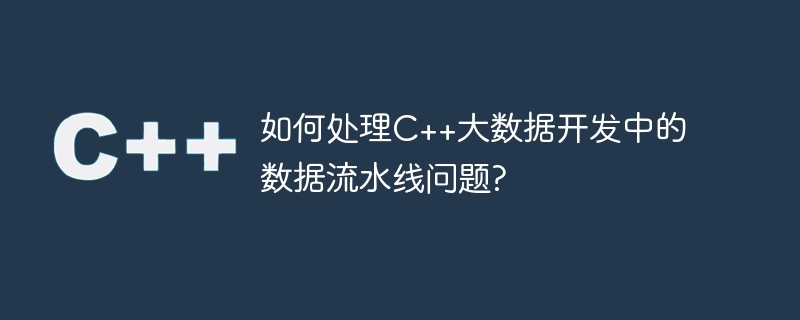
如何处理C++大数据开发中的数据流水线问题?
随着大数据时代的到来,处理海量数据成为了许多软件开发人员面临的挑战。而在C++开发中,如何高效地处理大数据流就成为了一个重要问题。本文将介绍如何使用数据流水线的方法来解决这个问题。
数据流水线(Pipeline)是一种将一个复杂的任务分解成多个简单的子任务,并通过流水线的方式将数据在子任务之间传递和处理的方法。在C++大数据开发中,数据流水线可以有效地提高数据处理的效率和性能。下面是一个使用C++实现数据流水线的示例代码:
#include <iostream>
#include <fstream>
#include <string>
#include <queue>
#include <thread>
#include <mutex>
#include <condition_variable>
const int BUFFER_SIZE = 100; // 缓冲区大小
const int THREAD_NUM = 4; // 线程数量
std::queue<std::string> input_queue; // 输入队列
std::queue<std::string> output_queue; // 输出队列
std::mutex input_mutex; // 输入队列互斥锁
std::mutex output_mutex; // 输出队列互斥锁
std::condition_variable input_condition; // 输入队列条件变量
std::condition_variable output_condition; // 输出队列条件变量
// 数据生产者线程函数
void producer_thread(const std::string& filename) {
std::ifstream file(filename);
if (!file) {
std::cerr << "Failed to open file: " << filename << std::endl;
return;
}
std::string line;
while (std::getline(file, line)) {
std::unique_lock<std::mutex> lock(input_mutex);
input_condition.wait(lock, [] { return input_queue.size() < BUFFER_SIZE; });
input_queue.push(line);
lock.unlock();
input_condition.notify_all();
}
file.close();
}
// 数据处理者线程函数
void processor_thread() {
while (true) {
std::unique_lock<std::mutex> lock(input_mutex);
input_condition.wait(lock, [] { return !input_queue.empty(); });
std::string line = input_queue.front();
input_queue.pop();
lock.unlock();
input_condition.notify_all();
// 进行数据处理的逻辑
// ...
// 将处理结果放入输出队列
std::unique_lock<std::mutex> output_lock(output_mutex);
output_condition.wait(output_lock, [] { return output_queue.size() < BUFFER_SIZE; });
output_queue.push(line);
output_lock.unlock();
output_condition.notify_all();
}
}
// 数据消费者线程函数
void consumer_thread() {
std::ofstream output_file("output.txt");
if (!output_file) {
std::cerr << "Failed to create output file." << std::endl;
return;
}
while (true) {
std::unique_lock<std::mutex> lock(output_mutex);
output_condition.wait(lock, [] { return !output_queue.empty(); });
std::string line = output_queue.front();
output_queue.pop();
lock.unlock();
output_condition.notify_all();
output_file << line << std::endl;
}
output_file.close();
}
int main() {
std::string filename = "input.txt";
std::thread producer(producer_thread, filename);
std::thread processors[THREAD_NUM];
for (int i = 0; i < THREAD_NUM; ++i) {
processors[i] = std::thread(processor_thread);
}
std::thread consumer(consumer_thread);
producer.join();
for (int i = 0; i < THREAD_NUM; ++i) {
processors[i].join();
}
consumer.join();
return 0;
}上述代码实现了一个简单的数据流水线,其中包含了数据生产者线程、数据处理者线程和数据消费者线程。数据生产者线程从文件中读取数据,并将数据放入输入队列;数据处理者线程从输入队列中取出数据进行处理,并将处理结果放入输出队列;数据消费者线程从输出队列中取出数据,并将数据写入文件。
立即学习“C++免费学习笔记(深入)”;
通过使用数据流水线,大数据的处理可以被有效地分解成多个独立的子任务,每个子任务可以并发地进行处理,从而提高处理效率。此外,通过使用互斥锁和条件变量来保证数据在流水线中的顺序处理和同步。
在实际的大数据开发中,还需要考虑错误处理、异常处理、性能优化等问题。但是数据流水线的基本原理和实现方式可以作为一个有效的参考。希望本文对您理解和使用C++大数据开发中的数据流水线提供了一些帮助。
以上就是如何处理C++大数据开发中的数据流水线问题?的详细内容,更多请关注php中文网其它相关文章!

c++怎么学习?c++怎么入门?c++在哪学?c++怎么学才快?不用担心,这里为大家提供了c++速学教程(入门到精通),有需要的小伙伴保存下载就能学习啦!

Copyright 2014-2025 https://www.php.cn/ All Rights Reserved | php.cn | 湘ICP备2023035733号